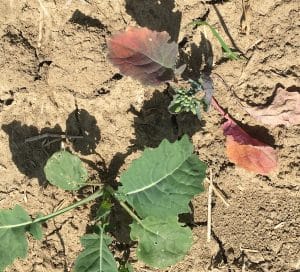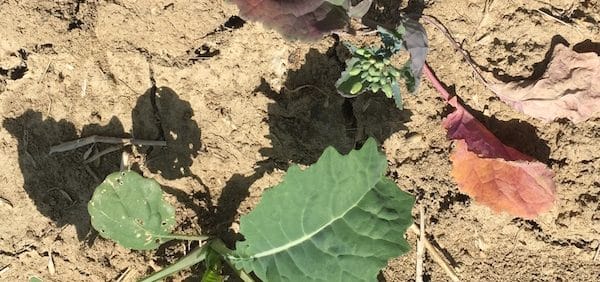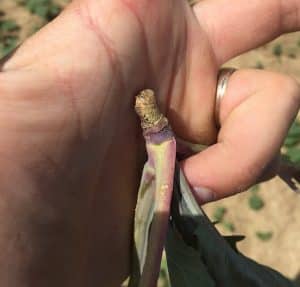Take a look at canola roots. Try a random search. Or target plants that look less than healthy for no apparent reason, like the one below.

Look for…
Foot rot/root rot Rhizoctonia infection at the bolting and flowering stages of the season can cause roots to pinch off at the crown — which is right around ground level. Roots will also show some browning around and below the girdling. This “browning” and “girdling” are what give brown girdling root rot (BGRR) its name. Foot rot, another similar rhizoctonia infection, can sever crown from roots entirely. Look for smooth clear rotting that is sometimes soft and squishy. More information.
Not symptoms: Dry rot (base of stem turns woody) is more likely to be blackleg.
Photos and more: https://www.canolawatch.org/2016/07/06/look-out-for-foot-rot-consider-rotations/
Root maggots. They can cause premature ripening (similar to some diseases), so identifying the proper cause can save you time and effort down the line. If the plant taproot breaks off slightly below the soil surface then root maggots are likely suspects. Look for maggots or tunneling. If the plant is girdled at or slightly above the soil surface, and taproots are not tunneled by root maggots, then a disease is more likely. No insecticides are registered or provide an economic benefit on root maggots. Crop rotation can provide effective management when numbers are high enough to cause yield loss. Maggot damage is often higher with low plant populations. Root maggot damage can increase the amount of root rot damage. There is also some theory that fields sprayed for flea beetles may have more root maggots because the flea beetle spray can kill off an important parasitoid of root maggots.
Clubroot galls. Look at fields with resistant and susceptible varieties. Clubroot resistant varieties can have galls, especially if the field has a clubroot strain for which the genetic trait provides limited protection. More information.
Blackleg. Look for dry rot that gives stems a woody and rough look. Some stem girdling and breaking can occur, but rot will be dry. Early blackleg infection can start to blacken the crown cross-section even at an early crop stage, and any blackening of the stem at this crop stage will often lead to dead or near-dead plants at maturity. Blackleg infection this severe probably started with leaf lesions at the cotyledon or first-leaf stages. These leaves are now gone, leaving no evidence of this early leaf infection. In cases where blackleg is this severe, infected pieces of old canola stubble are likely present in the field. Look for black spots of pseudothecia on old stubble pieces. Given the genetic differences in resistance from variety to variety, a distinct difference in infection rate could be evident when two varieties are grown in the same field.
Make the right call. A CCC agronomist got a call from a farmer who thought they had lots of cutworm damage in a field, but they scouted and couldn’t find any cutworms. The field was canola on canola. The agronomist went out and diagnosed it as clearly blackleg. The farmer wanted to spray, but spraying for cutworms would have no benefit if the issue was blackleg. And spraying for blackleg would be too late. Early infection causes the major yield loss and fungicide applied now would not eradicate existing disease, only protect against further infection. And while one would think stopping further infection might have a benefit, infection that occurs past the 4-leaf stage has little effect on yield.
In another similar case of damage mistaken for cutworms, the real cause turned out to be foot rot, as shown in the photos above and below. Read “Blackleg, foot rot or cutworms?”

